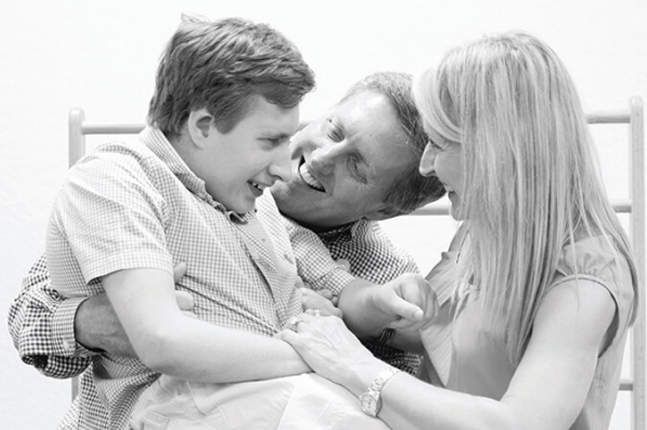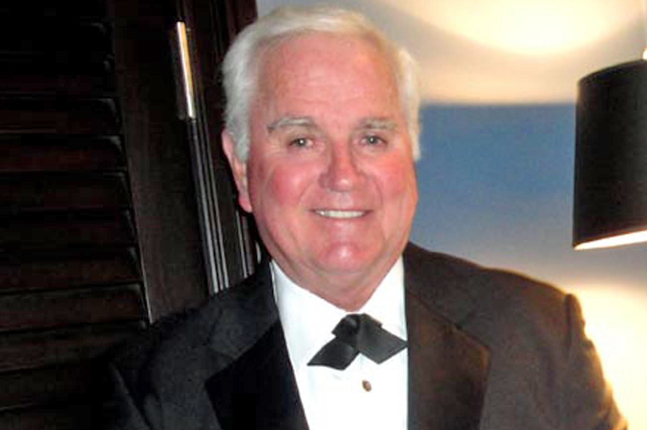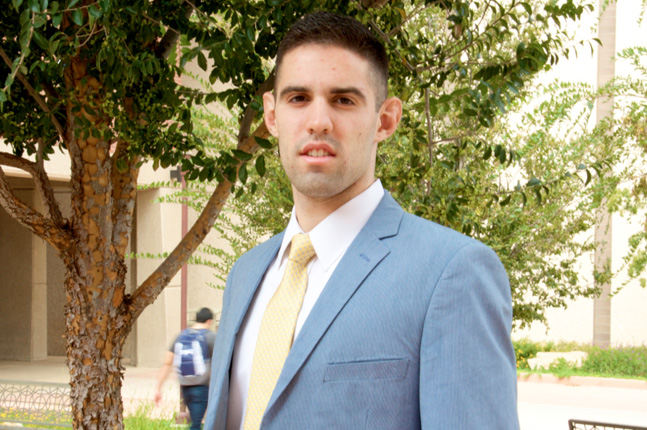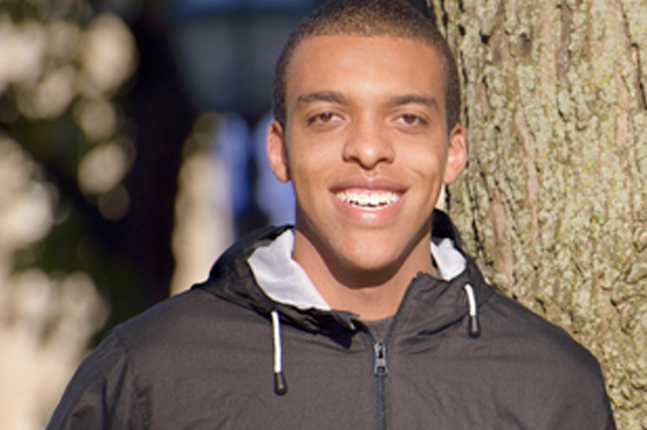Written by David K. Gibson of Rollins 360. Photo by Scott Cook.
Joseph Raymond lifts a small blue ball and passes it through the rungs of what looks like a broad wooden ladder. He grips the next ball and grimaces. His entire body seems to strain against the rubber ball as he passes it through the next set of rungs. Nothing about this is easy. Every lift and pass is an act of gritty perseverance. But Joseph isn’t alone in this struggle.
Vicky Szabo Raymond kneels facing her son, coaxing the ball through each successive set of rungs. Joseph’s father, Joe Raymond, crouches beside him on one knee, delivering a steady stream of encouragement into his son’s left ear. In a lot of ways, this moment is the culmination of more than two decades of determination.
Joseph was born with cerebral palsy in 1996, and Joe and Vicky soon struggled to find resources to effectively meet their son’s needs. Their search for a solution led them halfway around the world and has resulted in a revolution for the treatment of motor disabilities in the United States. In 2001, the Raymonds founded the Conductive Education Center of Orlando (CECO), and it’s become a lifeline for families of children with disabilities. But just like Joseph, Joe and Vicky aren’t alone in this struggle. A strong network of Rollins alumni, faculty, and students are helping CECO make an even bigger difference in Central Florida.
Searching for a Solution
Joseph Raymond was born three months prematurely, and the long days that followed called for extreme interventions and—at one point—ministration of last rites. Joseph survived but needed nearly 20 surgeries in his first three years. Joe and Vicky found themselves consumed by his medical needs. Vicky, a stay-at-home mother to two young daughters and a former teacher, was soon logging hour after hour each week taking Joseph to therapy appointments that seemed to lack either a cohesive plan or any real answers. Still, the Raymonds had hope. They felt sure there was a better way to tend to Joseph’s needs.
Vicky’s family is Hungarian, and through them she heard of a treatment called conductive education, founded by Hungarian doctor András Petö in 1945. His methods, based on the idea that even severely damaged nervous systems have the capacity to create new connections, put children into an active learning environment every day. By participating in challenging activities with the help of individual assistants, students take an integrative and consistent path to grow as typical children do—simultaneously developing physical, cognitive, and social skills. Vicky’s overseas relatives tried to persuade the family to enroll Joseph in the Petö Institute in Budapest, but rather than relocate the family, the Raymonds decided to bring the approach to the U.S.
In the summer of 2001, they invited families of children with similar diagnoses to a six-week program in a classroom at Sts. Peter and Paul Catholic Church in Winter Park. The space had been made available by the Rev. Sean Cooney, who led Sunday evening mass at Rollins—and who had delivered those last rites to Joseph a few years before. Six students were in the hands of a program conductor from the Petö Institute, who shooed the parents from the room. Because the conductor spoke little English, Vicky acted as interpreter to the parents. The first three days were difficult.
“The kids hated it,” Joe recalls. “They’d never had to work that hard before.”
But by the end of the program, the improvement was astounding. Joseph and the other children were engaged and happy, healthy, and directed.
A Swell of Support
Determined to bring this therapy to their child and to Central Florida, the Raymonds made a decision. Joe had recently sold his first business, Transworld Services Group (Inc. magazine’s 53rd fastest-growing privately held company in 1994), and he poured contacts and capital into setting up a full-time permanent program, which soon became CECO.
He and Vicky drew on their strong ties in the local community, particularly their friends from Rollins. Joe’s partner in TSG, John Riley ’83, delivered donations, doled out advice, and brought in other donors. John ’77 ’84MBA and Sandra ’78 Race, along with Victor ’73 and Jackie Shuttleworth Zollo ’73, were also big donors, there with “whatever we needed,” Joe says. Chuck Reynolds of Winter Park Construction gave freely of time, talent, equipment, and funds, while Vicky’s former classmate Mary Lopuszynski ’85, who now works for the United States Golf Association, brought in that organization to help with fundraising. There’s also been consistent support from Peter ’87 and Holly Allport, and Joe’s classmate Sergio Vallejo and his wife, Kim. Tres Loch ’07 ’08MBA, associate director of admission at Crummer Graduate School of Business, currently sits on CECO’s board of directors.
“The support has been incredible,” Joe says. “Rollins produces graduates that stay together as friends and help each other in the world.”
Aside from the board members and donors, there’s also consistent support from the Rollins student body. In fact, many of the 70 paid and volunteer assistants at CECO are Tars.
“Many are from the education department, of course,” says Rosene Johnson, executive director of the center, “but they’re also from the MBA program and from other undergraduate majors. They’re students who just want a chance to change a life.”
Small, Significant Success
Though it’s still small—only 36 students—CECO’s effect has been tremendous. In its 15 years of operation, the program has welcomed families from other states and even from overseas, each relocating to Central Florida to put their children into the program.
“We’ve changed the lives of not just the kids but the families,” Vicky says. Parents can see progress and suddenly they have lives that aren’t just shuttling their disabled child to appointments. Children are suddenly active all day and not simply seated in wheelchairs waiting for the next therapy session.
Therapy is baked into the daily program at CECO, which combines physical therapy, elementary education, speech therapy, and occupational therapy to treat the whole person. Each day paces students through a physical progression, starting with stretching before moving into sitting, standing, and walking. The students have daily chores as well, and they aren’t just work for work’s sake. They collect the mail, gather and sort laundry, set up the cafeteria—things that are vital to the proper functioning of a school.
Within the context of conductive education, that isn’t mere therapy or remedial education; it’s creating new neural pathways. “What Petö began back in the 40s, studies of neuroplasticity are backing up,” Johnson says. “In the right environment, with the right teachers and assistants, we’re now proving that this works.”
But while parents, seeing the results, are easily convinced, there are challenges to bringing this therapy to the wider educational environment. “In most school curricula,” Vicky says, “they only want to put money and time toward the academic, not realizing how integrated that is with the physical and social aspects. Here, everything physical they do is educational.”
Making the Case
Joe, ever the mindful businessman, knows that to succeed CECO will need funding, and to find that, conductive education will need some serious validation. To that end, he’s working with Rollins professor Don Davison to evaluate the progress of the students. Davison sat on the board of the center for several years and used data gathered there to teach statistics at the College—generating some quantifiable results in the process. CECO also has received a $300,000 National Science Foundation grant, thanks in large part to Pete McAlindon, Entrepreneur-in-Residence at Crummer and a CECO board member. That grant supports research into the use of technology like Xbox Kinect to measure pace, steps, and joint placement, thereby removing the subjectivity in therapy and making it available and effective for use between appointments.
“How much are we saving the state?” Joe asks. “We’re keeping families together, making students healthier through more activity, and eventually mainstreaming some of them in to typical classrooms. But we need validation to truly make that case.”
For Joseph and his family, that case is made. During a Wednesday morning class, he’s lying on a mat as an assistant begins his stretching routine. He’s surrounded by friends with challenges like his. They joke and laugh with each other as their hands are gently unfurled, their legs straightened, their necks massaged and relaxed.
“We get rave reports from his doctors, who can’t believe he is where he is developmentally,” Joe says. “Although he can’t walk, he’s socially very active and engaged. He’s physically active. He sleeps through the night. His quality of life is phenomenal. He’s a kid that was supposed to die within a month of being born and now he’s going to be 21 in February. It’s just unbelievable.”





